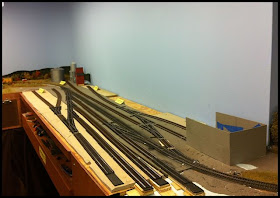You may have noticed a recent increase in the use of and articles about using paper based materials for structures on model railroads. Lance Mindheim has written about using prototype photos for the basis of structures on his relatively modern layout in multiple publications (www.lancemindheim.com). And there are a number of good examples of roofing and siding material printed on sheets of thicker paper by companies such as Kingmill, Clever, Paper Creek (out of business now) and others that you can find on-line, at your hobby shop and at train shows.
Recently while reading the ongoing saga of nearby modeler Rick Bickmore's steel mill themed layout over on the 'railroad-line' forum, Rick mentioned a British company offering some interesting paper based structures that he has been using for buildings on his layout. (check out Rick's discussion at http://railroad-line.com/forum/topic.asp?TOPIC_ID=20007&whichpage=104. Page 104 is right in the middle of the paper model discussion and has nice photos of Rick's 84 Lumber building. If you have some time, the other 100 or so pages that detail Rick's layout and model building are a pretty good read with lots of tips and ideas).
The company Rick mentioned was Scale Scenes, http://www.scalescenes.com/. They have a free download to try of a low relief brick building that would work well against the backdrop. The free download link is right off the main page.
What you get is a of PDF file that you print yourself. They have 2 different brick colors to choose from and a separate PDF download for the instructions. The instructions are great and I had no problem following along and building the model. The structure PDF itself I printed on a color printer. You need to resize the output to 87% to get true HO (they have instructions for printing to other scales as well). This was no problem at all. I also sprayed the output pages with Krylon Matte Finish to protect the ink and prevent it from damage during assembly.
The process involves gluing some of the sheets to thicker paper, such as matte board (Heavy Card), Poster Board (Medium Card) and 67lb paper (Light Card) to give you stronger sections and allow for gluing surfaces of walls ends. The web site has some details in the FAQ that can answer questions on what paper and card to use. Some of the sections are wrapped with another image and help build out the 3 dimensional details of the building. the door and window pieces are glued with clear styrene in between for window glazing. I used Canopy Formula 560 glue and that worked real well on this structure along with a glue stick for gluing larger sheet sections to their backers. Overall I found the kit to be really well thought out and convincing.
Here are pictures of the completed structure. Considering it cost me virtually nothing to build this, I am pretty happy. I like how it includes the 3 dimensional aspects such as the end pieces and roof caps, as well as the recessed window and interior office. There is just enough there to fool the eye. Some additional features, like down spouts and lights would also help.
 |
| Basic completed structure. I have not added any weathering to this at all, and may not need to. |
 |
| The interior office adds a lot of dimension, and I look forward to adding some people, a vehicle and other detail parts. |
I will probably investing a few "euros" and purchase one of their other kits. Rick discusses how he just used multiple print outs from one kit to give him plenty of siding material for the "paper-bash" of his 84 Lumber kit. I agree this is great idea and can really help get some structures on the layout, whether they are permanent or just mock ups.


